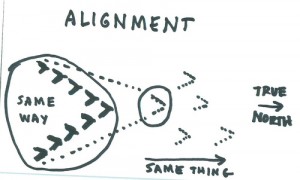Boost Demand Generation through Sales and Marketing Alignment
 We know successful deals aren’t created and closed by the sales team alone; there’s significant homage due to the marketing team in their demand generation efforts and kick-starting the funnel. To maximize outcome, the secret is to enable your business to boost demand generation through sales and marketing alignment. Don’t get us wrong—this doesn’t mean cutting the marketing team altogether and asking sales to take over (check out this case study); rather, have the two teams work harmoniously to achieve the best results.
We know successful deals aren’t created and closed by the sales team alone; there’s significant homage due to the marketing team in their demand generation efforts and kick-starting the funnel. To maximize outcome, the secret is to enable your business to boost demand generation through sales and marketing alignment. Don’t get us wrong—this doesn’t mean cutting the marketing team altogether and asking sales to take over (check out this case study); rather, have the two teams work harmoniously to achieve the best results.
Manage the Data
Between the two departments, data should be gathered and analyzed and best practices defined. When determining which strategies have proven most successful, keep in mind the four primary phases of demand generation: awareness, interest, preference, and commitment.
The goals here are to drive awareness and interest through successful inbound and outbound marketing that will enhance the sales cycle. In order to boost demand generation through sales and marketing alignment, both teams must be focused on determining the buyer persona. The marketing team gains awareness of and attention from potential prospects (suspects) through understanding who they are and what they want. This knowledge comes through the eyes of the sales team. By having a comprehensive profile of the current buyer persona, marketers can more directly target the audience and create more personalized campaigns, such as email marketing, which in turn drive higher return rates. Gather, analyze, and share the knowledge.
Guide Validation
Once the marketing team has generated demands, the next step is to convince the suspects that your solution is best through generating the leads. The marketing team has a plethora of ammunition to accomplish this: whitepapers, videos, blogs, reviews, direct mail, etc. Re-analyze and reuse the data collected from automated marketing solutions to further personalize each point of contact with the prospect to determine scoring and qualification, and pass only the qualified ones over to sales.
Nurturing the leads to the point of qualification comes when you boost demand generation through sales and marketing alignment. If the demand generation is low, activity in the pipeline is low, close rates are low. It’s key to have a solid grasp of the initial steps in order to maximize flow in the funnel to the closing steps. Implementing marketing programs that work together with a structured sales process will help to build awareness about your solution, remind prospects why your solution is better than others, and convert prospects into customers.






